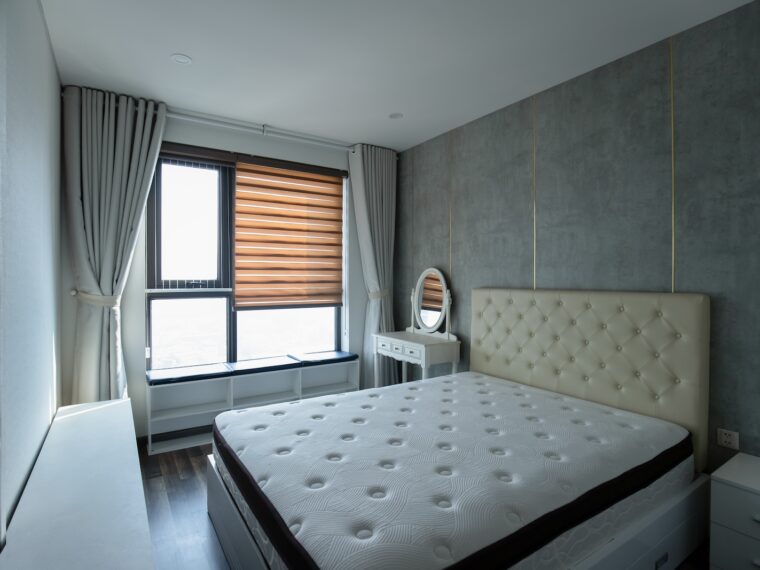If you’re shopping for a mattress and box spring, there are a few key aspects you must keep in mind when making your selection. First and foremost is weight capacity to ensure it can support both you and any others who sleep in it.
Box springs are wooden frames filled with springs or slats that support and raise your mattress, making it easier for you to enter and exit bed.
Size
Box springs come in various sizes, from twin to California king. When shopping for one, it’s essential to take the size of both your bed and any additional furniture in mind when shopping. Low profile box springs may be more suited to low bedside tables if necessary – with standard height being 9 inches while 5-6 inch high versions exist as alternatives.
Your mattress type can also play an integral part in making this decision, since certain mattresses work better with certain box springs than others. Traditional box springs, featuring coils inside of wooden frames, tend to pair best with innerspring mattresses while foundation-style box springs with no coils are best suited for memory foam and latex mattresses as they provide a sturdy base that offers support.
Other than size, other important considerations when purchasing a box spring are its material and features. Some are made from metal while others use wood or a combination of both materials; additionally they may feature different slat types from standard ones to more curved versions as well as coatings designed to repel mold, dust mites and allergens.
Also important when selecting a box spring is whether or not it has an integrated foundation, which makes assembly simpler and can prevent your mattress from sagging over time by keeping all corners supported by its support structure. This type of box spring will keep the mattress supported throughout its frame lifecycle and thus help ensure optimal support and an improved sleeping experience for you.
When purchasing a mattress and box spring set, consider getting it as part of an arrangement that includes discounted pricing and warranties that offer additional peace of mind. You’ll find these sets both online and in stores; make sure to read any fine print as some box springs have similar looks but differ significantly in price and material composition.
Material
Material choices when it comes to box spring construction can have a dramatic effect on how much support they provide and their compatibility with your mattress. Some come equipped with traditional coils while others feature wooden slats. Furthermore, the choice of material will affect durability of springs as well as how flexible foundation is.
Traditional coil box springs are the most widely used foundation type, as they’re designed specifically to work with innerspring mattresses. Typical sizes for twin, full, queen, king and California king mattresses. Their springs typically wrap in fabric before being housed within wood or metal cases for added support and flexibility. Coil box springs offer good support while still being compatible with modern mattresses but may lack flexibility compared to other foundation options.
Many contemporary mattress brands recommend using a box spring with their beds, while others do not specify one specifically. Saatva suggests box springs be used with mattresses under seven years old with proper center support to avoid sagging while Helix suggests box springs only be used with mattresses that feature wooden slats no more than four inches apart, plus an additional center piece of plywood added as support.
Most box springs are constructed of either wood or metal and covered in breathable fabrics to keep them clean and prevent dust mites. Unfortunately, however, box springs don’t always make an ideal base for every mattress type or weight capacity; so it’s essential that before purchasing one it be checked thoroughly to determine its suitability for each particular mattress type (for instance some may offer anti-fungal properties to help alleviate allergies and mold issues).
Many consumers avoid purchasing a box spring because it adds another cost and can make their mattress feel lumpy, instead opting for more cost-effective foundation options like platform beds or solid foundations that still support most types of mattresses, available from most department stores, with sleeker aesthetics and easier access. These beds may even create sleeker looks while making it easier for users to get in and out.
Firmness
Firmness is an important element of mattress performance and there’s no one-size-fits-all approach when it comes to firmness options. Sleepers vary based on weight, body type and preferred sleeping positions – therefore there’s a range of firmness choices available to them that cater for this individuality. Some mattresses also provide cushioned materials to ease pressure points on your body while other may feature less malleable surfaces for more rigid support.
Selecting the ideal mattress firmness can help alleviate back pain and improve posture while decreasing risks such as sagging or sinking. A great mattress will feature consistent levels of firmness throughout both its center and edge areas for optimal results.
Box springs are wooden frames filled with either springs or metal grids designed to provide support for mattresses of most traditional mattress sizes, from twin to king. Box springs provide a firm base that absorbs shock, increasing lifespan while increasing comfort levels and lifespan of mattresses. They come in standard twin through king sizes. Box springs have become an increasingly popular choice as solid bases that create solid bases and extend lifespan and comfort levels of mattress systems.
Modern mattresses don’t always require a box spring; some feature built-in foundations or platform beds that rest directly on wooden slats. Some even feature low profiles that make getting in and out easier. When using one of these mattresses, make sure that its bed frame matches well – whether a solid metal platform bed frame, wooden and steel combination bed frames would all work equally well.
Bed frames that are compatible with both traditional mattresses and box springs may also include headboards and footboards; depending on the style of these, additional hardware may be required depending on its style. Many frames should work just fine when combined together – just double check all details to be certain!
Box springs may be the go-to option for innerspring mattresses, but hybrid and latex models often don’t need one. Heavier mattresses made with memory foam or latex should sit atop a platform or other elevated bed base instead; box springs would only make these too bouncy and wear down more quickly than necessary.
Warranty
Box springs come in various varieties: metal or wood construction with coils or slats for support and comfort, foam padding to provide extra support and cushion, or multiple sizes ranging from twin, full, queen, king or even smaller box springs specifically tailored for children’s beds.
Before purchasing a box spring, always check with its manufacturer’s recommendations for their products. Some mattress companies will invalidate warranties if used with non-approved springs; additionally they may suggest specific foundation or bed frames to pair with your mattress.
Many mattresses and box spring sets are sold together as packages to make finding your ideal set easier and cheaper than purchasing each item separately. Furthermore, many come with warranty terms equivalent to that of their respective mattress models.
Most mattress and box spring sets offer various height options to meet your sleeping preferences. If you prefer your mattress sitting low to the ground, opt for a low-profile box spring that stands only 4 or 5 inches high; or for added height consider selecting one between 7-9 inches high.
Some box springs come in two separate pieces for easy maneuverability through narrow hallways and doorways, and others even come equipped with special features to enhance sleep comfort such as organic fabrics or back support enhancements.
Some box springs can support more weight than others; so make sure that any box spring you consider can accommodate both your mattress and any sleepers using it, along with any furniture in your room (headboard and footboard, for instance). Its weight capacity should be listed in its description – but if uncertain, contact the salesperson to inquire further.




